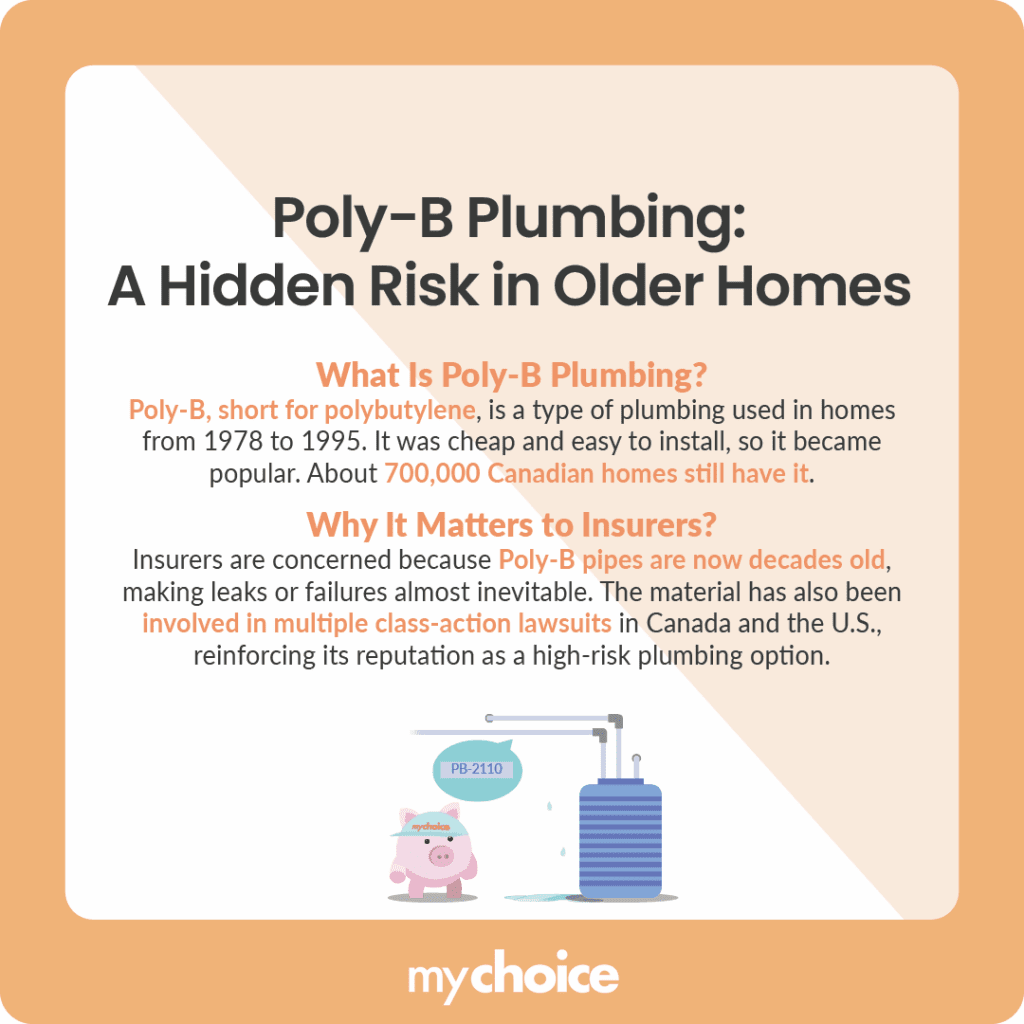If your house is relatively old, then it may still have polybutylene (Poly-B) plumbing. It used to be popular a few decades ago, but with age, this type of plumbing is generally well past its reliable lifespan.
What Is Poly-B Plumbing and Why Does It Matter to Insurers?
Polybutylene, also known as Poly-B, is a type of plumbing material manufactured from approximately 1978 to 1995 for residential plumbing use. It was widely popular due to its reliability as well as its cheaper price compared to copper piping. The Government of Alberta estimated that around 148,000 homes in the province have poly-B plumbing, with an estimated 700,000 homes across the country.
Insurers are concerned about Poly-B piping due to its age. Since many of these plumbing systems are decades old, most insurers and plumbers would agree that failure is a matter of when, not if. Additionally, Poly-B piping has also been subject to multiple class action lawsuits in Canada and the United States, including a lawsuit that represented all homeowners in Ontario who had Poly-B piping in their homes, reinforcing its reputation as a potentially unsafe option for plumbing.

The Age Penalty: Why Homes With 30+ Year Old Poly B Are Riskier Than Ever
Generally, homes built in Canada between 1975 and 1997 used Poly-B piping until it was banned by the National Plumbing Code in 1997. However, it wasn’t completely banned until the Government of Canada officially did so in 2005 due to the increasing number of lawsuits.
With that in mind, if your home is around 30 to 50 years old, it may have Poly-B plumbing. If your home is about that age and hasn’t had any plumbing problems yet, it may just be a matter of time before you encounter plumbing failure since it’s way beyond its reliable lifespan.
While Poly-B pipes were affordable and easy to work with, the material had many flaws. Here are some common issues encountered by Poly-B pipes:
Can I Get Insured if I Have Poly-B Plumbing?
You can still obtain home insurance if your house has Poly-B plumbing, but it may be more challenging since insurance companies are generally reluctant to take on clients with high-risk plumbing in their homes. While some insurers won’t insure you at all, some may impose higher premiums or water damage deductibles. You may also receive a limited policy with terms like water damage exclusions.
If you can’t get insured through regular means because your home still has Poly-B plumbing, you can consider high-risk home insurance.
How Much Does It Cost to Replace Poly-B Plumbing
Poly-B plumbing replacement costs vary depending on factors like:
- The construction of your home, since homes with basements have easily accessible pipes. Larger homes also usually have more pipes to change.
- The type of pipe you want to replace Poly-B with. Cross-linked polyethylene pipes (PEX) are generally cheaper than copper pipes.
Generally, the cost to replace Poly-B plumbing is on average between $1,500 and $15,000.
What You Can Do As a Homeowner to Reduce Your Risk
As a homeowner, the best way to reduce the risk of Poly-B pipe failure is to replace your pipes immediately. However, if you can’t do that at the moment, there are some ways to reduce your pipe failure risk in the meantime:
Alternatives to Re-Piping: What Should You Do?
Aside from a complete re-piping, there’s no cost-effective or surefire way to fix Poly-B piping. The material is prone to failure, and even if you still want to keep Poly-B piping because a total replacement is too expensive, you may need a full replacement if pipe failure occurs anyway, as Poly-B piping is no longer manufactured.
Rather than dealing with a potential flood and having to re-pipe anyway, we recommend re-piping as soon as you’re able to prevent unexpected expenses. Additionally, you may find it easier to qualify for home insurance if your home doesn’t use Poly-B piping anymore.
Key Advice from MyChoice
- If your home is 30 to 50 years old, you should check your plumbing to determine whether it uses Poly-B pipes.
- Plumbers and insurers consider Poly-B pipes as ticking time bombs that are very likely to fail, so pipe replacements are highly recommended.
- You can prevent further damage by reducing water temperature and lowering the chlorine load, but those are just stopgap measures while you wait for proper pipe replacements.








